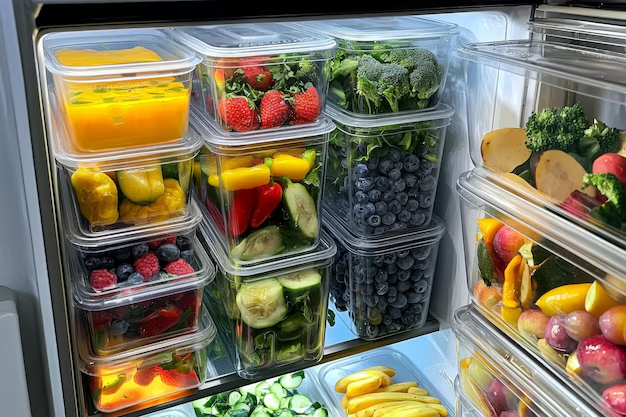Is Your Refrigerator Freezing Your Food? Here's Why and How to Fix It
Have you ever reached into your refrigerator expecting a crisp lettuce or a juicy strawberry only to find them frosty and hard? While your fridge plays an essential role in keeping your food fresh, nobody wants their produce or dairy items turned into blocks of ice. Let's explore why your refrigerator may be freezing your food and how you can address this issue effectively.
Understanding the Basics of Refrigeration
Before diving into solutions, it's helpful to know how a refrigerator works. The primary role of a refrigerator is to slow down bacterial growth by keeping food at safe temperatures, generally between 35°F (1.6°C) and 38°F (3.3°C). The freezer, on the other hand, aims to keep foods at 0°F (-18°C) to preserve them over longer periods. A fridge that's running too cold can lead to unintended freezing, which isn't ideal for most perishables.
Common Causes of Frozen Food in the Refrigerator
Temperature Settings
1. Incorrect Temperature Settings:
One of the most straightforward reasons can be incorrect temperature settings. Most refrigerators come with a thermostat that might be set too low. Tip: Ensure your fridge is set to the manufacturer's recommended level.
Airflow Issues
2. Blocked Air Vents:
Refrigerators rely on good airflow to maintain consistent temperatures. If items are blocking the air vents, cold air might be directed to a specific area, freezing the food there. Action: Keep the vents clear of any items.
3. Uneven Air Distribution:
The refrigerator's internal fan helps distribute air evenly. If the fan isn't working correctly, you might experience uneven cooling. Check: Listen for the fan when the door is closed; a significant noise or silence can indicate a problem.
Mechanical Problems
4. Damaged Gaskets:
The door gasket forms a seal that keeps cold air inside. If it's damaged, cold air could escape, leading the fridge to work harder and cooler than necessary. Solution: Inspect the gasket and replace if there are any cracks or tears.
5. Thermostat Malfunction:
If the thermostat is faulty, it might not accurately regulate the temperature, causing the refrigerator to become too cold. Fix: Consider consulting an appliance technician for a replacement.
User Habits
6. Overloading the Fridge:
Packing your fridge too tightly can restrict airflow, creating hot and cold spots. Recommendation: Leave adequate space around items for proper air circulation.
7. Frequent Door Opening:
Frequently opening the fridge increases warm air entry, prompting the system to work overtime, which can lead to incorrect temperatures. Suggestion: Minimize door-open times and ensure it’s fully closed.
Troubleshooting and Solutions
DIY Solutions
Adjusting Temperature Settings
- Locate the Thermostat: Usually found inside on the back wall or in the fridge's upper compartment.
- Adjust Carefully: Move it incrementally, allowing a few days between adjustments to gauge effectiveness.
Checking the Door Seal
- Inspection: Run your hand along the seal for air leaks.
- Repair: Use petroleum jelly for a temporary fix or replace the gasket.
Ensuring Proper Air Circulation
- Organize strategically: Store items in designated areas (dairy in door bins, meats in drawer sections, etc.).
- Conduct periodic cleaning: Keep vents and fans free of dust and debris.
When to Call in a Professional
If DIY solutions do not resolve the freezing issue, seeking professional help might be necessary. Technicians can assist with:
- Thermostat Repair/Replacement
- Fan and Motor Assessments
- Comprehensive Diagnostic Services
An expert can effectively diagnose and repair parts not easily accessible or visible to the untrained eye.
Preventive Measures
🔍 Regular Inspections and Maintenance:
- Monthly Checks: Inspect gaskets, fans, and settings regularly to avoid future headaches.
- Decadal Cleaning: Empty the refrigerator and clean the interior at least twice a year to minimize bacteria and maintain efficiency.
Keeping Foods Fresh and Safe
⚖️ Balancing the Load:
- Organize by zone: Different shelves may have varying temperature preferences. Stash the more sensitive items like leafy greens and berries towards the middle shelves rather than near vents.
📦 Use Spillproof Containers:
- Avoid clutter: Organized storage allows better visibility and priorities, minimizing door-open times.
Understanding why your refrigerator might be freezing food can help maintain the health of both your appliance and stored goods. By applying a combination of troubleshooting steps, DIY fixes, and preventive maintenance, you can ensure your refrigerator serves its purpose effectively without compromising on food quality.
Maintaining your refrigerator doesn't only preserve your groceries but also conserves energy and extends the lifespan of your appliance. Keeping on top of maintenance makes life simpler and saves you money in the long term, ensuring your fridge works efficiently as part of your everyday life.
